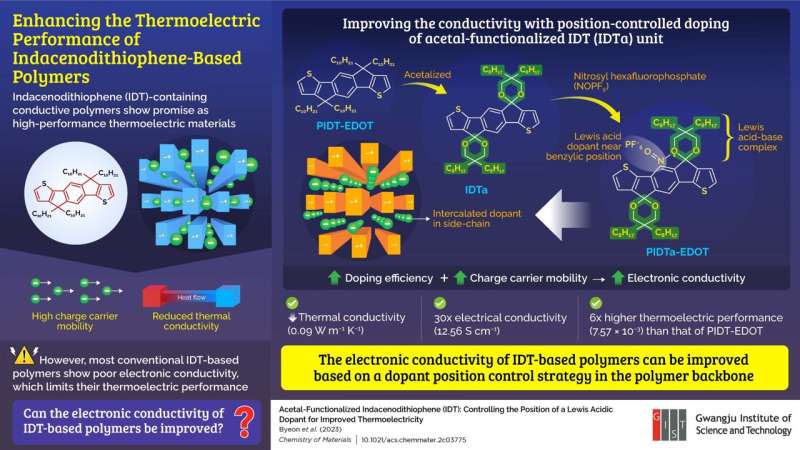This article has been reviewed according to Science X's editorial process and policies. Editors have highlighted the following attributes while ensuring the content's credibility:
fact-checked
peer-reviewed publication
proofread
Enhancing thermoelectricity with guided impurity position control

Thermoelectric materials, substances that convert temperature difference into electricity, find a multitude of applications involving the conversion of waste heat into useful electrical energy. However, they often need to rely on heavy rare earth elements for efficient thermoelectric conversion.
This, unfortunately, makes them expensive and environmentally hazardous. In recent years, conjugated polymer-based material has received attention as an environmentally benign alternative to the conventional rare earth metal-based thermoelectric materials.
Owing to their high charge carrier mobility in the amorphous state, IDT-containing conductive polymers have the potential to reduce thermal conductivity while keeping their electronic conductivity intact. Unfortunately, these polymers suffer from low electronic conductivity, limiting our ability to synthesize high-performance thermoelectric materials from IDT-based polymers.
A team of researchers led by Prof. Sukwon Hong Gwangju Institute of Science and Technology in Korea have now found a solution to the problem. Equipped with their understanding of plausible reasons for the observed low conductivity, the team designed a novel strategy for developing an IDT-based polymer with improved thermoelectric performance based on dopant (impurity) position controlling within an acetal-functionalized IDT (IDTa) polymer. Their study was made available in Chemistry of Materials.
The team chose PIDT-EDOT, a copolymer of IDT and then acetal-functionalized it to form PIDTa-EDOT. Next, they synthesized a Lewis-acid base complex by introducing nitrosyl hexafluorophosphate (NOPF6), a Lewis acidic dopant into the IDTa component. The addition of the acetal group was crucial, since it directed the dopant next to the benzylic position of the polymer skeleton, facilitating the desired dopant position control.
"We showed that the low conductivity of conventional IDT results from their non-polar side chains, which cause the dopant to be located between the polymer chains (backbone) instead of at the side chains. This, in turn, impedes charge transfer. Accordingly, we proposed a strategy that would allow us to place the dopant near the sidechains of the polymer backbone," explains Prof. Hong, when asked about the motivation behind the study.
Upon testing the PIDTa-EDOT polymer, the researchers observed an improved doping efficiency, condensed π−π stacking, and reduced grain size. These, in turn, imparted a low thermal conductivity of 0.09 W m−1 K−1 on one hand and 30 times higher electronic conductivity on the other. As a result, the PIDTa-EDOT polymer demonstrated a 6-fold improvement in thermoelectric performance compared to that of pristine PIDT-EDOT polymer.
The study thus presents a new approach to synthesizing IDT-based polymers that simultaneously exhibit low thermal conductivity and high electronic conductivity, a prerequisite for developing efficient thermoelectric materials and thermoelectric conversion technology.
"Improved thermoelectric materials could lead to more efficient electricity generation from the waste heat released in industrial processes or even from the human body. This, in turn, could reduce energy consumption and make solar power more practical and cost-effective," concludes Prof. Hong.
More information: Jinhwan Byeon et al, Acetal-Functionalized Indacenodithiophene (IDT): Controlling the Position of a Lewis Acidic Dopant for Improved Thermoelectricity, Chemistry of Materials (2023). DOI: 10.1021/acs.chemmater.2c03775
Journal information: Chemistry of Materials
Provided by GIST (Gwangju Institute of Science and Technology)





















